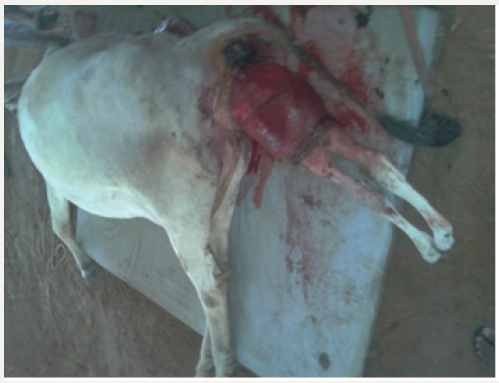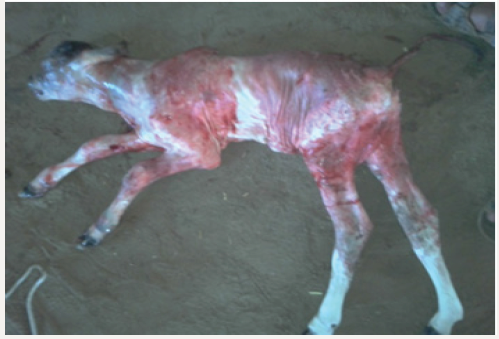Lupine Publishers | Journal of Veterinary Science
Introduction
Case History and Observations
A five year old, full term pregnant, Kankrej cow of her second parity was presented to the Jalaram Gauseva Kendra, Bhabhar, district Banaskantha. The history revealed that the cow was in labour since last day. The true water bag was ruptured before 3hrs and progress of two hind limbs was noticed at vulvar orifice. The owner has made efforts to deliver the fetus by application of traction at both hind limbs. The cow was in lateral recumbency with eversion of vagina and the fetus was presented at external so in posterior longitudinal presentation, lumbo-sacral position with the hind limbs protruding out of the cervix (Figure 1).Treatment
The cow was brought on the dorsal recumbancy and epidural anaesthesia was induced with 6ml of 2% lignocain hydrochloride. Inj. Dexamethasone 5ml was injected before the intervention. The dorsal aspect of the external so of the cervix was incised to widen the passage and calving rope was applied at the pastern joint of both hind limbs. The cervix was hold at the external so and gentle forced traction was applied on the calving rope. The dead male fetus was delivered (Figure 2). The placenta was removed manually, the incision was sutured using chromic catgut #1 and the prolapsed mass was relocated as per standard procedure. Four boluses of Oxytetracycline hydrochoride were placed in uterus. The cow was treated with Inj. DNS- 4 lit. I/v, Inj. RL-2 lit. I/v, Inj. Analgine-15ml I/m, Inj.Oxytetracycline Hydrochloride 40ml I/v and Injection Chlorpheneramine maleate 10ml I/m. The cow could not survive and succumbed to death after 3 hrs of the treatment.Discussion
For more Lupine Publishers
Open Access Journals Please visit our website https://lupinepublishers.us/
For more Journal
of Veterinary Science articles Please Click Here: https://lupinepublishers.com/dairy-veterinary-science-journal/
To Know more about Open
access Publishers, click on Lupine
Publishers


No comments:
Post a Comment
Note: only a member of this blog may post a comment.